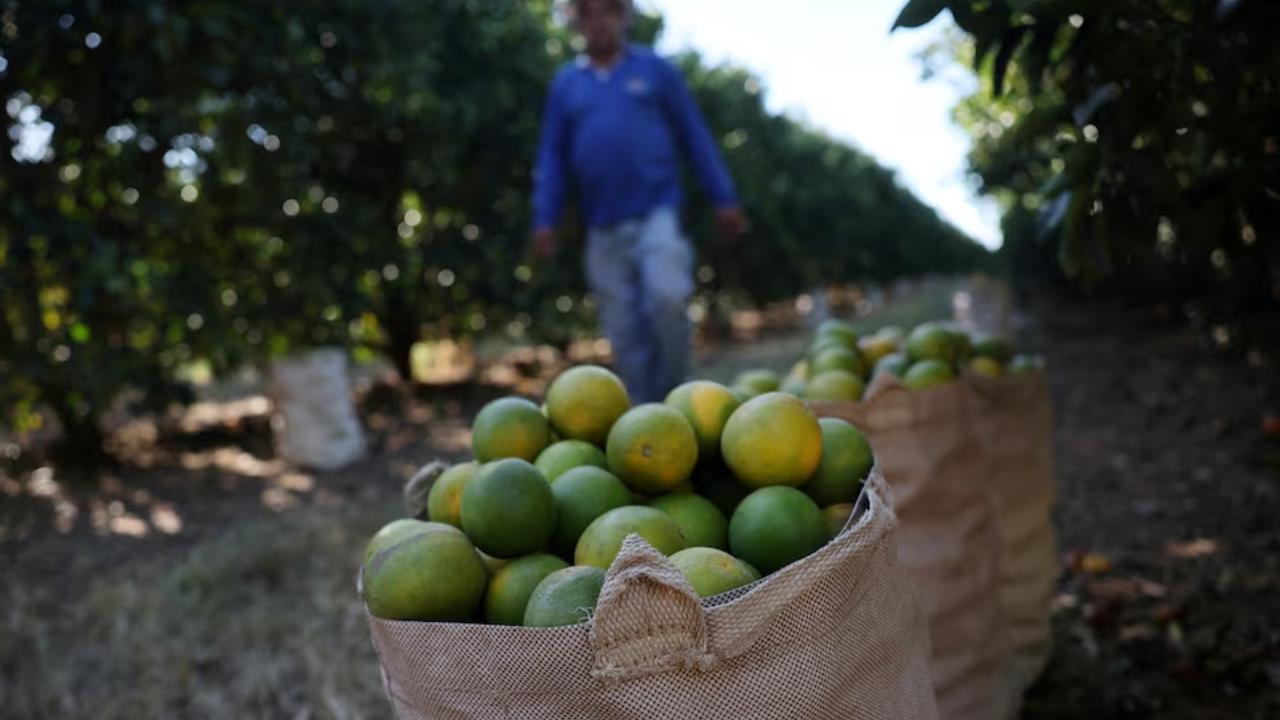
Post by : Monika
Photo: Reuters
Brazil, the largest producer and exporter of oranges and orange juice in the world, is facing a major challenge. A bacterial disease called citrus greening, also known as Huanglongbing (HLB), has spread across nearly half of Brazil's citrus belt, affecting millions of trees.
The disease is caused by a bacterium carried by the Asian citrus psyllid, a tiny insect that feeds on the sap of citrus trees. This disease has a devastating impact on the fruit quality, tree health, and overall production, which threatens the livelihoods of farmers and the global orange juice supply.
Citrus greening is considered one of the most destructive citrus diseases in the world. In Brazil, it has been steadily increasing for years, causing substantial losses and posing a serious threat to one of the country’s most important agricultural industries.
What Is Citrus Greening Disease?
Citrus greening is a bacterial disease that infects citrus trees, including oranges, lemons, and limes. It spreads primarily through the Asian citrus psyllid, a small insect that feeds on leaves and branches. When the insect feeds on an infected tree, it carries the bacterium to other healthy trees, spreading the disease rapidly.
Once a tree is infected, there is no cure, and it can continue to produce low-quality fruit for several years before dying. The disease reduces yields, fruit size, sweetness, and juice quality, making it a significant problem for farmers who rely on high-quality oranges for the juice and export markets.
Spread and Impact in Brazil
According to Fundecitrus, a research institute supported by the Brazilian citrus industry, the spread of greening disease has increased for eight consecutive years. Currently, it affects 48% of the citrus belt, which includes the key producing states of São Paulo and Minas Gerais. These regions are responsible for the majority of Brazil’s orange production.
For the 2024/2025 season, Brazil’s orange output is estimated at 230.9 million 40.8-kilogram boxes, the lowest in several years. This decline is largely due to the widespread impact of greening disease. Farmers have reported significant losses in both fruit quality and quantity, which has affected their income and the overall economy of citrus-producing regions.
The disease has been estimated to cause annual losses of around $120 million, a significant economic impact for the industry. Additionally, the spread of greening disease has made Brazil's citrus trees more vulnerable to other stresses, such as droughts, floods, and pest infestations, further reducing productivity.
Global Implications
Brazil is the world’s largest producer and exporter of oranges, making its struggle with greening disease a global concern. The disease has already affected other major citrus-producing regions, including Florida in the United States, where greening has been a problem for over a decade. The decline in Florida’s orange production has increased the world’s reliance on Brazilian oranges and juice.
As a result, any reduction in Brazil’s orange production affects international markets, raising prices for orange juice and citrus products. Countries that rely on Brazilian oranges, including the United States, Europe, and Asia, are monitoring the situation closely.
Moreover, citrus greening has caused the death of more than 50 million trees in Asia and 10 million trees in Africa in the past seven years. The global spread of this disease highlights the need for international cooperation to develop effective strategies for managing and preventing its impact.
Efforts to Combat Citrus Greening
Brazilian scientists, farmers, and government agencies are working together to combat greening disease through a variety of strategies:
1. Research and Development
Scientists are conducting research to develop disease-resistant citrus varieties and investigate methods to treat or manage infected trees. New technologies, including biological control, improved fertilizers, and plant breeding, are being explored to improve the resilience of citrus trees.
2. Controlling the Psyllid
Efforts to reduce the population of the Asian citrus psyllid are ongoing. Farmers use insecticides and biological control measures, such as introducing natural predators of the psyllid. These strategies aim to limit the spread of the bacteria from infected trees to healthy trees.
3. Farmer Education
Educating farmers about early detection, sanitation, and proper tree management is crucial. Farmers are trained to remove infected trees promptly, monitor for psyllids, and follow best practices to reduce the spread of the disease.
4. Government Support
The Brazilian government provides financial support, technical assistance, and subsidies to farmers affected by greening. This support helps farmers replace lost trees, purchase insecticides, and maintain healthy groves.
5. Integrated Pest and Disease Management
A combined approach that includes tree removal, insect control, and resistant varieties is considered the most effective method for slowing the spread of greening disease.
Forecasts and Future Outlook
Fundecitrus initially forecasted that Brazil’s orange production for the 2025/2026 season would reach 314.6 million boxes. However, due to the continued impact of greening disease, this forecast has been revised downward by 2.5% to 306.74 million boxes.
Although the production is expected to improve compared to the current season, the disease remains a long-term threat to Brazil’s citrus industry. Experts emphasize that ongoing research, farmer cooperation, and government support will be essential to maintain productivity and prevent further losses.
If greening disease continues unchecked, it could lead to permanent reductions in tree numbers, fewer exports, and higher costs for orange juice worldwide. Addressing the disease is not only crucial for Brazil’s economy but also for global citrus supply and prices.
Challenges in Managing the Disease
Importance of Global Cooperation
Citrus greening is not just a Brazilian problem—it is a global challenge. Countries such as the United States, China, and several African nations have struggled with the disease. Sharing research, technology, and best practices is essential to prevent further losses worldwide.
Collaborative efforts could include:
Citrus greening disease has become one of the most serious threats to Brazil’s orange industry, affecting nearly half of the country’s citrus belt. The disease reduces fruit quality, lowers yields, and causes economic losses for farmers.
While Brazil has implemented measures to fight the disease, including research, psyllid control, and farmer education, greening remains a persistent and long-term problem. Scientists and farmers must continue working together to protect trees, improve management practices, and develop resistant varieties.
The global importance of Brazil’s citrus industry means that controlling greening disease is crucial not only for local farmers but also for international orange juice markets. With continued investment, research, and collaboration, there is hope that the impact of citrus greening can be reduced, ensuring the sustainability of Brazil’s citrus industry for years to come.










NBA Friday Recap: Powerhouse Wins for Miami, LA, Milwaukee, and Clippers
Miami, LA Lakers, Milwaukee, and Clippers triumphed in a thrilling NBA Friday, showcasing standout p

Doncic Shines with 49 Points in Lakers' 128-110 Victory over Timberwolves
Luka Doncic dazzles with 49 points as the Lakers secure a 128-110 win against the Timberwolves, show

Kings Triumph Over Jazz 105-104 with Last-Minute Sabonis Effort
The Sacramento Kings edged out the Utah Jazz 105-104, with Domantas Sabonis making the decisive shot

Argentina's Friendly Match Against India Delayed, New Date to be Announced
The friendly match between Argentina and India in Kochi has been postponed due to FIFA approval dela

Rohit and Kohli Conclude ODI Journeys in Australia with a Victory
Rohit Sharma and Virat Kohli bid adieu to Australian ODIs with a final win, forming a 168-run partne

George Russell's Wrestling Mask Antics at Mexican Grand Prix
George Russell donned a wrestling mask to enjoy the Mexican Grand Prix from the stands, providing a